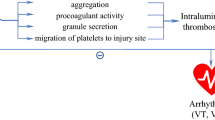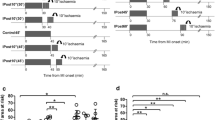Abstract
Protection from postconditioning has been documented in in situ animal models and it has been proposed that it is targeting circulating leukocytes. We therefore tested whether postconditioning can protect leukocytefree, buffer–perfused rabbit hearts. Infarct size was measured with triphenyltetrazolium staining. In control hearts undergoing 30 min of regional ischemia and 2 h of reperfusion, 33.3 ± 2.2% of the risk zone infarcted. The protocol previously used in open–chest animals of four postconditioning cycles of 30 s reperfusion/30 s ischemia starting at the beginning of reperfusion decreased infarction to only 24.8 ± 2.5% of the risk zone in these isolated hearts. Because of the meager protection induced by four 30 s postconditioning cycles, we evaluated the effect of postconditioning with 6 cycles of 10 s reperfusion/10 s ischemia starting at the beginning of reperfusion. Robust salvage was seen with only 10.4 ± 3.4% of the risk zone infarcting (p < 0.001 vs control and p < 0.003 vs 4 cycles of 30 s ischemia). The 10s protocol was used in all studies of signal transduction. Wortmannin (100 nM), a phosphatidylinositol 3– (PI3–) kinase antagonist, infused for 20 min starting 5 min before reperfusion, blocked postconditioning’s, protection (31.2 ± 4.2% infarction) as did 1H–[1,2,4]oxadiazole[4,3–a]quinoxalin–1–one (ODQ) (2 µM) a guanylyl cyclase inhibitor (36.9 ± 5.3%) and 8–p–(sulfophenyl) theophylline (SPT) (100 µM), a non–specific adenosine receptor blocker (34.2 ± 2.8%). Thus, postconditioning’s protection is not dependent on circulating blood factors or cells, and its anti–infarct effect appears to require PI3–kinase activation, stimulation of guanylyl cyclase and occupancy of adenosine receptors. These signaling steps have also been identified in preconditioning and during pharmacologic cardioprotection and suggest commonality of a protective mechanism.
Similar content being viewed by others
References
Baxter GF, Ebrahim Z, Yellon DM (2000) Amp579, an A1/A2A agonist, limits infarct size at reperfusion via a p42/p44 MAPK-dependent pathway. Circulation 102:II–212 (Abstract)
Baxter GF, Mocanu MM, Brar BK, Latchman DS, Yellon DM (2001) Cardioprotective effects of transforming growth factor-β1 during early reoxygenation or reperfusion are mediated by p42/ p44 MAPK. J Cardiovasc Pharmacol 38:930–939
Bell RM, Yellon DM (2003) Bradykinin limits infarction when administered as an adjunct to reperfusion in mouse heart: the role of PI3K, Akt and eNOS. J Mol Cell Cardiol 35:185–193
Budde JM, Velez DA, Zhao Z-Q, Clark KL, Morris CD, Muraki S, Guyton RA, Vinten-Johansen J (2000) Comparative study of AMP579 and adenosine in inhibition of neutrophil-mediated vascular and myocardial injury during 24 h of reperfusion. Cardiovasc Res 47:294–305
Gross ER, Hsu AK, Gross GJ (2004) Opioid-induced cardioprotection occurs via glycogen synthase kinase β inhibition during reperfusion in intact rat hearts. Circ Res 94:960–966
Hausenloy DJ, Mocanu MM, Yellon DM (2004) Cross-talk between the survival kinases during early reperfusion: its contribution to ischemic preconditioning. Cardiovasc Res 63:305–312
Heusch G (2004) Postconditioning: Old wine in a new bottle? J Am Coll Cardiol 44:1111–1112
Jonassen AK, Sack MN, Mjøs OD, Yellon DM (2001) Myocardial protection by insulin at reperfusion requires early administration and is mediated via Akt and p70s6 kinase cell-survival signaling. Circ Res 89:1191–1198
Kin H, Zhao Z-Q, Sun H-Y, Wang N-P, Corvera JS, Halkos ME, Kerendi F, Guyton RA, Vinten-Johansen J (2004) Postconditioning attenuates myocardial ischemia-reperfusion injury by inhibiting events in the early minutes of reperfusion. Cardiovasc Res 62:74–85
Liao Z, Brar BK, Cai Q, Stephanou A, O’Leary RM, Pennica D, Yellon DM, Latchman DS (2002) Cardiotrophin-1 (CT-1) can protect the adult heart from injury when added both prior to ischaemia and at reperfusion. Cardiovasc Res 53:902–910
Liu GS, Thornton J, Van Winkle DM, Stanley AWH, Olsson RA, Downey JM (1991) Protection against infarction afforded by preconditioning is mediated by A1 adenosine receptors in rabbit heart. Circulation 84:350–356
Murry CE, Jennings RB, Reimer KA (1986) Preconditioning with ischemia: a delay of lethal cell injury in ischemic myocardium. Circulation 74:1124–1136
National Research Council (1996) Guide for the Care and Use of Laboratory Animals. 7th ed. National Academy Press, Washington, D. C.
Smits GJ, McVey M, Cox BF, Perrone MH, Clark KL (1998) Cardioprotective effects of the novel adenosine A1/A2 receptor agonist AMP 579 in a porcine model of myocardial infarction. J Pharmacol Exp Ther 286:611–618
Tsang A, Hausenloy DJ, Mocanu MM, Yellon DM (2004) Postconditioning: a form of “modified reperfusion” protects the myocardium by activating the phosphatidylinositol 3-kinase-Akt pathway. Circ Res 95:230–232
Xu Z, Downey JM, Cohen MV (2001) AMP 579 reduces contracture and limits infarction in rabbit heart by activating adenosine A2 receptors. J Cardiovasc Pharmacol 38:474–481
Xu Z, Downey JM, Cohen MV (2003) Timing and duration of administration are crucial for antiinfarct effect of AMP 579 infused at reperfusion in rabbit heart. Heart Dis 5:368–371
Xu Z, Yang X-M, Cohen MV, Neumann T, Heusch G, Downey JM (2000) Limitation of infarct size in rabbit hearts by the novel adenosine receptor agonist AMP 579 administered at reperfusion. J Mol Cell Cardiol 32:2339–2347
Yang X-M, Krieg T, Cui L, Downey JM, Cohen MV (2004) NECA and bradykinin at reperfusion reduce infarction in rabbit hearts by signaling through PI3K, ERK, and NO. J Mol Cell Cardiol 36:411–421
Yang X-M, Proctor JB, Cui L, Krieg T, Downey JM, Cohen MV (2004) Multiple, brief coronary occlusions during early reperfusion protect rabbit hearts by targeting cell signaling pathways. J Am Coll Cardiol 44:1103–1110
Zhang SJ, Yang X-M, Liu GS, Cohen MV, Pemberton K, Downey JM (2003) CGX- 1051, a peptide from Conus snail venom, attenuates infarction in rabbit hearts when administered at reperfusion. J Cardiovasc Pharmacol 42:764–771
Zhao Z-Q, Corvera JS, Halkos ME, Kerendi F, Wang N-P, Guyton RA, Vinten-Johansen J (2003) Inhibition of myocardial injury by ischemic postconditioning during reperfusion: comparison with ischemic preconditioning. Am J Physiol 285:H579–H588
Author information
Authors and Affiliations
Corresponding author
Rights and permissions
About this article
Cite this article
Yang, XM., Philipp, S., Downey, J.M. et al. Postconditioning’s protection is not dependent on circulating blood factors or cells but involves adenosine receptors and requires PI3–kinase and guanylyl cyclase activation. Basic Res Cardiol 100, 57–63 (2005). https://doi.org/10.1007/s00395-004-0498-4
Received:
Revised:
Accepted:
Published:
Issue Date:
DOI: https://doi.org/10.1007/s00395-004-0498-4




